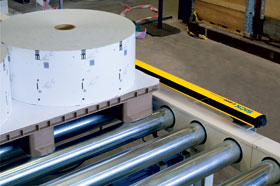

Over the last century, combinations of progress in regulations, along with advances in technology, have dramatically improved the metric of workplace-related safety.
Perhaps the oldest, and most consistently used, family of opto-electronic devices for personnel protection is safety light curtains, typically used as an alternative to mechanical barriers and other forms of physical machine guarding. By reducing the need for these physical barriers, light curtains can increase the maintainability, operability and the efficiency of the machines they are being used to protect.
Light curtains belong to the category of safety equipment, referred to as presence detection devices, and are typically supplied as a pair, consisting of a transmitter and a receiver. The transmitter projects a series of parallel infrared light beams from an array of LEDs. The receiver has a similar array of photoelectric cells, constantly monitoring the light beams from the sender. When an object breaks one or more of the beams, the receiver interprets this as an intrusion into a dangerous area and a protective stop signal is sent to the guarded equipment.
The light beams are sequenced and pulsed at a specific frequency by the transmitter, while the receivers are designed to accept only the light beam from its dedicated transmitter. This allows for the rejection of spurious ambient light sources and enhances their suitability as components of a safety system.
Solutions for material transfer
Light curtain systems with muting functions are usually used in material transfer applications. Muting refers to the temporary disabling of the safety function to allow certain objects to pass through without tripping the safety system.
Muting was often considered to be the only option in these applications because of its historical use, but this is no longer true. In 2005 a new technology was commercially introduced that improves safety performance and cost-efficiency of light curtains in material transfer applications. Light curtains using pattern and object recognition require few, or no, ancillary sensors, less wiring and provide a safety solution more secure than simple muting.
From a safety assessment point of view, both solutions satisfy EU Type 4 (SIL 3, PL e) requirements. However, it is much easier to deliberately defeat the muting sensors mounted on a conveyor than it is to fool a light curtain equipped with recognition technology.
Object and pattern recognition in light curtains
Object and pattern recognition is used to differentiate between a person walking through the protective field of a light curtain, or goods being transported through it. The size, shape, transport speed, distance between objects and number of expected objects, can all be programmed via a computer into the safety system along with desired tolerances. It is also possible to enable a teach-in function to accomplish the set-up, eliminating the necessity for a computer on-site.
The ability to read beam data makes object and pattern recognition particularly valuable in material transfer applications. For example, the system can recognise and read the legs of a pallet ie, it can see that the legs are a certain distance away from each other and that they are a certain size. By monitoring this information, the light curtain ensures that only recognised objects, in this case the pallet, are allowed through the safety field.
A recent expansion on this technology allows for the dissemination of this data into the non-safety related part of the control system for monitoring, feedback and processing purposes. This means that not only will the safety light curtain distinguish between goods and people, but it can also send information about the goods through to the control system without affecting the safety function.
Bottom line advantages
Lower capital costs: less wiring and fewer sensors. Traditional muting systems require a set of safety light curtains, two to four muting sensors, a safety relay and a muting module to control the muting functions. Object and pattern recognition light curtains do not require any external sensors or muting control modules. The only external piece of equipment required is the safety relay.
Lower labour costs: less wiring and less equipment to mount and configure translates to less time on site and lower installation costs.
Better detection: traditional muting systems make use of an ‘educated guess’ to determine whether an object should be allowed through a light curtain’s safety field. Object and pattern recognition light curtains are able to reliably recognise the difference between an expected object and a person.
Ease of configuration and minimised downtime: fewer components means less possibility of damage. Software configuration files can be stored and downloaded into a set of replacement light curtains within minutes and no realignment of muting sensors is required.
Typical applications
Object and pattern recognition light curtains are ideal for material transfer applications, such as palletising or de-palletising, end-of-line packaging and automated assembly in the automotive, food and beverage and consumer goods industries. They are particularly useful in high-speed, high-volume distribution centres.
The technology’s ability to work with a large number of objects and configurations is a huge advantage, especially when the material being transported is not a normal pallet, or solid block of goods. Not surprising, the technology has made tremendous inroads into the automotive sector, where car bodies of varying shapes and sizes are being transferred throughout the production process.
Object and pattern recognition technology is transforming the safety light curtain into a more effective tool for material transfer applications.
For more information contact Stephen Eltze, SICK Automation SA, +27 (0)11 472 3733, [email protected], www.sickautomation.co.za
| Tel: | +27 10 060 0550 |
| Email: | [email protected] |
| www: | www.sick.com/za/en/ |
| Articles: | More information and articles about SICK Automation Southern Africa |

© Technews Publishing (Pty) Ltd | All Rights Reserved